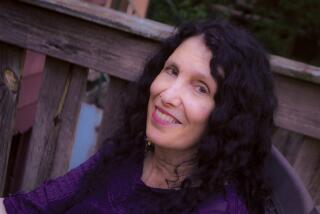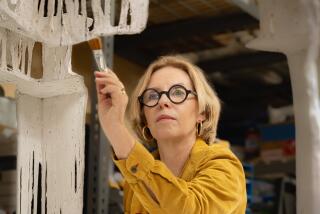Susan Orlean’s adaptation to Los Angeles
With a dog at her feet and an advance copy of her book “Rin Tin Tin” on the table, Susan Orlean sips coffee in the backyard of the Los Angeles house she now calls home. In September, the New Yorker staff writer, whose book “The Orchid Thief” was the (sort of) basis for the film “Adaptation,” left rural New York behind. For the next year, she, her husband and son will be calling themselves Angelenos, thanks partly to the movie-star dog and Orlean’s responsibilities as a working mother.
“I started being inflamed with the idea that Rin Tin Tin was a great story, but I didn’t know what the story was, of course,” says Orlean, who begins all her work with lively curiosity before plunging into the unknown. The story — about a puppy rescued from the battlefields of World War I by an American soldier and the long, rich, movie-and-television legacy the two created — meant doing extended research in California. She got the book contract in 2004; a few months later, she was pregnant. Traveling to the archives she needed on the West Coast, she soon realized, would mean being apart from her young son.
“Before I had a family, I would have simply come out for a couple of weeks, come home, come back out a few more weeks as needed,” Orlean says. “Well, that just wasn’t going to work. I didn’t know what to do. There was a moment where I thought, ‘I don’t know if I can do the book.’”
The solution was to do exactly the kind of long-term, immersive research she always had — in writing about taxidermy, a high school basketball player, a lady bullfighter — but bring the whole family out for a month. Orlean’s husband, John Gillespie Jr., was selling his company, so he was available to pick up stakes — fairly well-heeled stakes, in fact. But having an au pair, as they do, doesn’t address the key issue for Orlean. “It’s hard to be a professional and be not a parent but a mother,” she says. “Children have a primal connection to their mother — I’m telling you, it’s hard-wired.”
Her smart phone pings repeatedly with emails and alarms. Her latest story, on fashion designer Jean-Paul Gaultier, was in final edits for the New Yorker’s Monday issue. “I feel like I’m still sorting this out,” she muses. “In spite of the perception of it being the perfectly suited job to having children, it may be exactly ill-suited to being a parent.”
Orlean’s family found a Los Angeles that was increasingly enticing to them. In sublets in Malibu, Venice and the Hollywood Hills, they extended their planned one-month visit to more than four. After bouncing around, they wondered if instead of subletting they should invert the process and buy a place of their own to use when needed.
Then they found the Schindler house. It was love: panicked, seesawing, what-are-we-doing love. They bought it in 2007, and this year — sparked by a new business opportunity for John — is the first time they’ve been able to stay there for more than a long holiday.
The house is impeccably restored and Midcentury beautiful but also human in scale. It’s an architecturally significant home that feels livable; the living room is modestly sized, featuring an era-appropriate couch with rumpled red-orange cushions. The small garden out back is sheltered by greenery, framing a view of the San Fernando Valley without revealing the neighbors, who by the sound of things are mostly birds and the occasional chain-saw user. On a recent morning, a coyote passed through.
As sylvan as that sounds, it’s nothing compared to the 55 rural acres they’ve been living on in Columbia County, N.Y. When she first tweeted about her move to Los Angeles on Twitter, the most common response from her more than 184,000 followers was, basically, “What about the chickens?!?” On her New Yorker blog Free Range, Orlean has written with fascination and fondness about her chickens as well as their other critters, from cattle to cats. After some thought, the family brought the dog and two of three cats with them to the city.
“I think each time you move, it’s like a booster rocket. The pure newness of your circumstance super-fuels your curiosity,” she says. Orlean was brought up in Cleveland, went to college in Michigan and then moved to Portland, Ore., where she wound up writing for Willamette Week, a local alternative paper. She was assigned to cover the county, which typically would mean attending governmental meetings; her first story, written around 1980, was about amyl nitrate, its popularity and easy availability. “My editor said, ‘You’re supposed to be covering the county’; I said, ‘It’s taking place in the county,’” she remembers. “Then I did another story like that, and another one, and he finally said to me, ‘Just do what you want.’”
Ever since, people have allowed Orlean close enough into their lives so that she can tell her stories in depth. Perhaps her petite size disarms them, but more likely it’s her wide smile and evident enthusiasm. She has a uniquely tuned native curiosity that allows her to see how the micro connects to the macro. She moved on to the Boson Phoenix, the Boston Globe, Vogue and Rolling Stone, writing for many other venues along the way. She has been a New Yorker staff writer since 1992.
“I like going places that other people may not be interested in going. I have this fantasy — this would be almost impossible, but I’d love to walk the length of Ventura Boulevard,” she says. “I feel like it’s this insane, huge, pulsing artery — I just want to look in, what is this crazy shop? What’s this weird little restaurant? It’s the Broadway of L.A., or it feels that way to me — so much going on.”
Ever since that long-ago story in Oregon, she’s been driven by an enthusiastic, unbounded curiosity — a symptom she embraces.
“I’m not looking for anything in particular. I just love exploring, and I love cities. And I also love country,” she says. “I guess I kind of love everything.”
More to Read
Sign up for our Book Club newsletter
Get the latest news, events and more from the Los Angeles Times Book Club, and help us get L.A. reading and talking.
You may occasionally receive promotional content from the Los Angeles Times.







